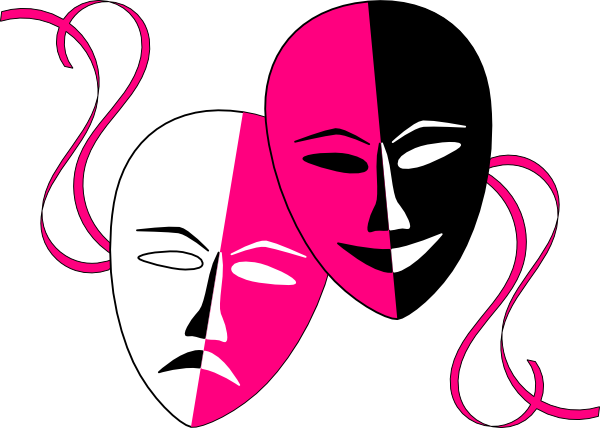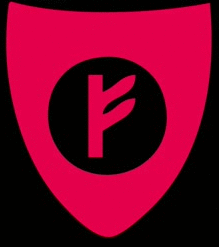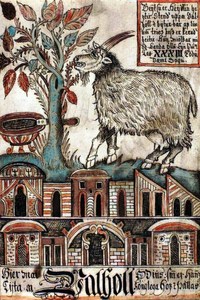
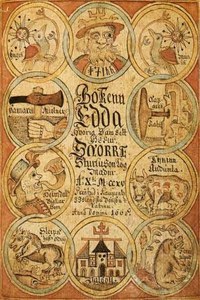
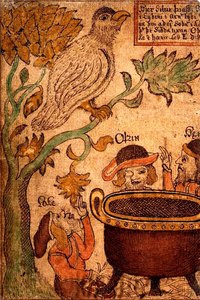
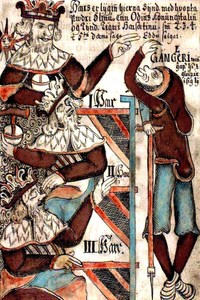
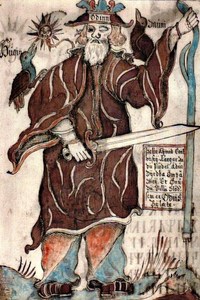
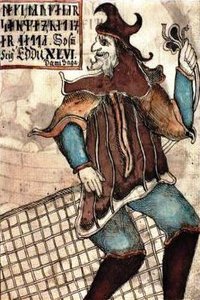
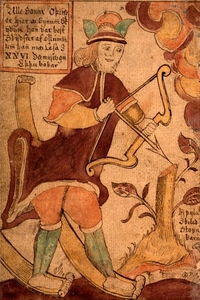
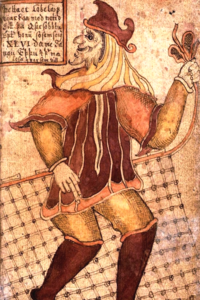
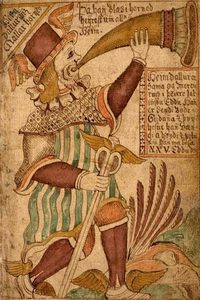
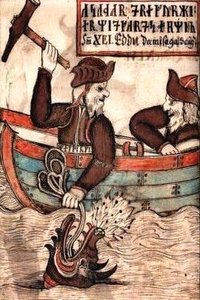
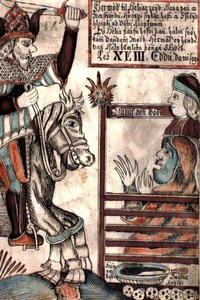
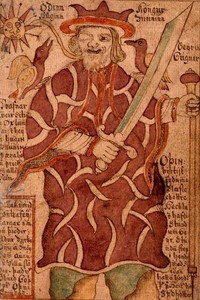
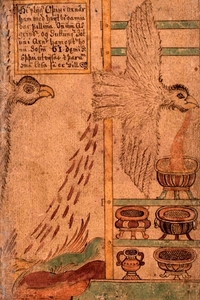
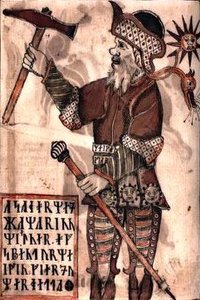
Runes are an ancient writing system used by the Germanic and Norse tribes that archeologically date back to circa 150 A.D. Throughout time the alphabet had undergone modifications until this form of writing was replaced by Latin. Their oldest known alphabet and the most commonly used today for divination is the Elder Futhark with the origin of the name coming from the first six letters of the alphabet Fehu, Uruz, Thurisaz, Ansuz, Raidho, and Kenaz spelling out F-u-th-a-r-k. All-Father Odin, the supreme god of war, poetry, culture, knowledge and wisdom, legendarily conducted a deliberate self-sacrifice ritual of hanging for nine day while staring into the Well of Destiny called Urds to receive the mystic wisdom of the “runes,” secret magic letters. The rune symbols were then carved onto the trunk of the world-tree to carry these messages to their Nine Worlds.
Lengthy poems were the major source of rune writings and somewhat the Rosetta Stone for the understanding of this enigmatic language and culture. An anonymous collection of poems called Poetic Edda outlines the story of the Norse god Odin and his quest for the runes that not only gained him wisdom but also well-being. According to the Hávamál poem, meaning Words of the High One, Odin purportedly received the knowledge of the runes through self-sacrifice; essentially he sacrificed himself to himself for their wisdom as stated in this except of the poem:
Wounded I hung on a wind-swept gallows
For nine long nights,
Pierced by a spear, pledged to Odin,
Offered, myself to myself
The wisest know not from whence spring
The roots of that ancient rood (cross or crucifix).
They gave me no bread,
They gave me no mead,
I looked down;
With a loud cry
I took up runes;
From that tree I fell.
–The Words of the High One (Hávamál) - original Icelandic by W. H. Auden and P. B. Taylor
Norse mythology contends that the runic alphabet is of divine origin. From their scant written history found in these stories and poems and the meaningful names of the symbols postulates that the runes hold magical healing properties and mystical divination energy. From the earliest inscriptions, there are some indication that runes were not used as a rudimentary writing system but as magical signs for charms and spells. However, evidence of runes being used for divination is more inferred than fact. The word rune means secret, mystery or something hidden. In fact, the Hávamál poem speaks of the power to bring the dead back to life:
I know a twelfth one
if I see up in a tree,
a dangling corpse in a noose,
I can so carve and colour the runes,
that the man walks
And talks with me.
As for runic magic, the letters Ansuz (wisdom) and Tiwaz (victory) evidently carried particularly magical significance. However, various combination of letters appear to have been used in undecipherable chants, and the runic charm word Alu (ᚨᛚᚢ) may have functioned as a metaphorical pentacle or protector of some sort. Two runestones in Sweden refer to the writings as “runes of power,” a handful of runstones throughout the Nordic countries included curses, and the Poetic Edda poems have stanzas that indicate the casting of spells for ships, childbirth and fateful signs. Runic inscriptions of victory on sword hilts have also been unearthed. There are a number of other historical sources that detail the casting of lots by such tribes.
It is known that Germanic tribes had many methods of divination and a diverse repertoire for reading omens. Cornelius Tacitus, Roman Senator and historian, offered a detailed account in 98 A.D. of their readings of lots:
They attach the highest importance to the taking of auspices and casting lots. Their usual procedure with the lot is simple. They cut off a branch from a nut-bearing tree and slice it into strips these they mark with different signs and throw them at random onto a white cloth. Then the state's priest, if it is an official consultation, or the father of the family, in a private one, offers prayer to the gods and looking up towards heaven picks up three strips, one at a time, and, according to which sign they have previously been marked with, makes his interpretation. If the lots forbid an undertaking, there is no deliberation that day about the matter in question. If they allow it, further confirmation is required by taking auspices.
Circa 200 A.D., Northern Europe’s runic interpretations became wide spread. Although many modifications came and some went, the Elder Futhark has 24 symbols with the modern addition of a blank rune, which is preposterous and has no meaning. Words are a way a culture thinks and runes are no exception. For example the first letter of the alphabet is Fehu meaning cattle and wealth; to the ancient Norse cattle were wealth. Below are quick pronunciations and brief meanings of each letter. For a detailed description of each rune, click on the rune icon or the rune name.

 Fehu (fay-who) cattle meaning wealth or money
Fehu (fay-who) cattle meaning wealth or money

![]() Uruz (oor-ooze) wild ox meaning strength or health
Uruz (oor-ooze) wild ox meaning strength or health

 Thurisaz (thoor-ee-sawz) giant meaning evil or suffering
Thurisaz (thoor-ee-sawz) giant meaning evil or suffering
 Ansuz (awn-sooze) Odin meaning wisdom or prosperity
Ansuz (awn-sooze) Odin meaning wisdom or prosperity
 Raidho (ray-though) riding meaning journey or movement
Raidho (ray-though) riding meaning journey or movement
 Kenaz (kane-awze) fire meaning enlightenment
Kenaz (kane-awze) fire meaning enlightenment
 Gebo (ghay-boe) gift meaning forgiveness or generosity
Gebo (ghay-boe) gift meaning forgiveness or generosity
 Wunjo (woon-yoh) joy meaning happiness or satisfaction
Wunjo (woon-yoh) joy meaning happiness or satisfaction
 Hagalaz (haw-gaw-laws) hail meaning destruction or disruption
Hagalaz (haw-gaw-laws) hail meaning destruction or disruption
 Nauthiz (now-these) need meaning demand or desire
Nauthiz (now-these) need meaning demand or desire
 Isa (ee-saw) ice meaning stagnation*
Isa (ee-saw) ice meaning stagnation*
 Jera (yar-awe) harvest meaning fertility or change
Jera (yar-awe) harvest meaning fertility or change
 Eihwaz (eye-wawz) yew tree meaning weapon or defense
Eihwaz (eye-wawz) yew tree meaning weapon or defense
 Perthro (perth-row) ice meaning chance or mystery*
Perthro (perth-row) ice meaning chance or mystery*
 Algiz (all-geese) pine meaning protection or opportunity
Algiz (all-geese) pine meaning protection or opportunity
 Sowilo (soe-eee-low) sun meaning revelation or success
Sowilo (soe-eee-low) sun meaning revelation or success

 Tiwaz (tee-whaz) god/warrior meaning victory or courage
Tiwaz (tee-whaz) god/warrior meaning victory or courage
 Berkano (ber-ka-noh) Birch twig meaning awakening or growth
Berkano (ber-ka-noh) Birch twig meaning awakening or growth
 Ehwaz (ay-wawz) horse meaning trust or friendship
Ehwaz (ay-wawz) horse meaning trust or friendship
 Mannaz (mawn-nawz) man/kind meaning self or inner being
Mannaz (mawn-nawz) man/kind meaning self or inner being
 Laguz (law-gooze) water meaning the unknown or cleansing
Laguz (law-gooze) water meaning the unknown or cleansing
 Ingwaz (eeng-wawz) lord meaning harmony or peace
Ingwaz (eeng-wawz) lord meaning harmony or peace
 Dagaz (day-gauze) day meaning transformation or breakthrough
Dagaz (day-gauze) day meaning transformation or breakthrough
 Othala (oath-awe-law) home & family meaning inheritance or possessions
Othala (oath-awe-law) home & family meaning inheritance or possessions
* Poem interpretations ambiguous or contradictory
There are many other interpretations for each letter. Nothing is set in stone and when casting runes outside of doing one for a Tarot reading, take into consideration the nearby runes in your reading. Old and new rune aficionados have accentuated the runes oracle mystic as magic talismans and the idea of divine inspiration brought down from gods for spiritual arousal for us mere mortals. Whatever the case, runes have lasted the test of time and have sparked a burgeoning interest from their oracle properties.
Home
